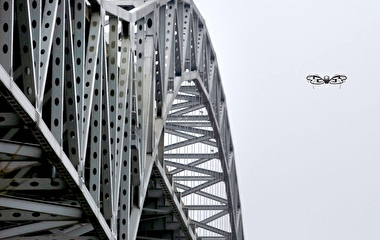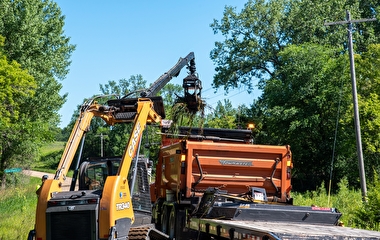U of M researchers have developed a new method for estimating one of the key measures of bridge health—vertical displacement—using sensors installed on the I-35W St. Anthony Falls Bridge, expanding industry knowledge of how to use smart sensors.
“We need to learn more about sensors because they’re a newer technology that we don’t have a lot of experience with,” says Benjamin Jilk, complex analysis and modeling design leader with the Minnesota Department of Transportation (MnDOT) Bridge Office. “This study gave us valuable information about accelerometers and the information they provide.”
Sensors help designers and bridge managers learn more about how bridges shift and flex over time. Accelerometers measure structural vibrations triggered by traffic under varying environmental conditions.
In the MnDOT-funded study, investigators used the sensor systems on the Minneapolis bridge to design and analyze a procedure for measuring and monitoring vertical displacement on bridges under traffic forces and environmental variability. Since September 2008, the St. Anthony Falls Bridge has carried traffic over the Mississippi River while funneling sensor data from more than 500 smart sensors to researchers and MnDOT bridge engineers. The detailed data from these sensors could serve as an alternative to time-consuming inspections, and researchers wanted to know if accelerometers could be used to measure vertical displacements and help monitor bridge health.
Researchers began by developing models to estimate bridge loads and displacements using vibration frequency data gathered by the bridge’s accelerometers. In the laboratory, investigators evaluated the impact of bridge loading on displacement and vibration frequencies and then compared the laboratory findings to the effectiveness of their model. Finally, they tuned the modeling approach to the St. Anthony Falls Bridge data to determine how well the procedure could estimate vertical displacement and assess its potential for evaluating other MnDOT bridges.
Ultimately, researchers discovered that the new method was able to measure vertical displacement on bridges, but that the approach is not effective for this particular bridge because its extreme stiffness does not allow for the generation of meaningful displacements under reasonable traffic speeds.
“This technique is pretty innovative,” says Lauren Linderman, an assistant professor in the Department of Civil, Environmental, and Geo- Engineering. “The procedure development was successful, but the application to this structure was less successful. Some of the metrics identified in this technique could be useful in other monitoring approaches.”
As smart bridge technology and its uses develop, investigators will consult the methods and findings in this study and may adopt some of its procedures in future research work.




